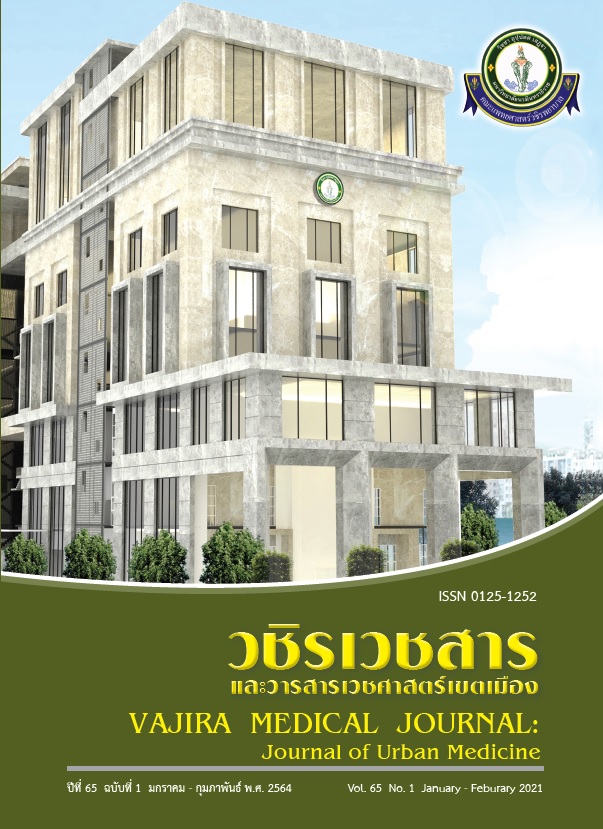Physiologic and Other Effects of Silicone Mask Respirator N99 in the Coronavirus 2019 Outbreaks
Main Article Content
Abstract
Introduction: The coronavirus outbreak which has spread across the world resulting in a significant shortage of the N 95 type of medical mask. For this reason, the University of Navamindradhiraj jointly developed a medical mask made from silicone type N 99 (Silicone Mask Respirator N 99) that filters more than 99% of bacteria and viruses. This research shows the study of respiratory physiology and the impact of using N 99 silicone mask in general volunteers.
Methods: A prospective study was carried out by 20 volunteers breathing through a HEPA filter fitted with a silicone N 99 mask doing routine work and testing for breathing through volumetric capnography every 1 hour until at the end of 3-hours. The required measurements were measured dead space volume (Vd), dead space volume / tidal volume (Vd / Vt), end- tidal CO2 (EtCO2), alveolar CO2, oxygen saturation, airway resistance and a satisfaction questionnaire after all studies were performed.
Results: Total 20 subjects were eight males and twelve females, mean age was 31 years (SD), mean body mass index was 21.60 ± 2.23 kg / m2 and no underlying disease. Volumetric capnography was used to calculate the respiratory parameters. With silicone N 99, the average dead space volume increased 27.57 ± 7.57 ml( p=0.001). The mean proportion of dead space volume / tidal volume before and after wearing the N 99 silicone mask was 0.22 ± 0.03 and 0.25 ± 0.03 respectively, with 0.03 increments (p = 0.011). End- tidal CO2 measurements before and after wearing the N 99 silicone mask were found to be 35.35 ± 2.32 mmHg and 36.71 ± 2.25 mmHg (p = 0.054). When calculating alveolar CO2 before and after wearing silicone N 99 was 32.94 ± 3.06 mmHg and 34.52 ± 2.64 mmHg respectively (p = 0.085). Respiratory resistance measurements before and after wearing the N 99 silicone mask was 2.53 ± 0.37 cmH2O/L/sec and 4.14 ± 0.8 cmH2O/L/sec increased by 1.53 ± 0.72 cmH2O/L/sec (p <0.001). The oxygenation value before and after using the mask is normal (p = 0.355). According to the user satisfaction questionnaire, there was no headache in the volunteers. Respiration heat and stinging, irritation, sweating, odor, scores were 1-2 points (not at all uncomfortable to a little uncomfortable), and masked communication and mask tightening were scored 2-3 points range (a little uncomfortable to moderately uncomfortable).
Conclusion: When the silicone mask N 99 was continuously used for while it has shown that respiratory dead space and resistance were increased statistically significant but results of oxygenation and carbon dioxide levels were typical throughout use. It is therefore safe to use the N 99 silicone mask.
Downloads
Article Details
References
Navamindradhiraj University. Manual of innovation for safety NMU-PAPR-2, NMU- mini PAPR, VJR-NMUN99 [internet]. 2020 [cited 2020 May 30]. Available from: http://www.nmu.ac.th>uploads>2020/04.
Bourgoin P, Baudin F, Brossier D, Emeriaud G, Wysocki M, Jouvet P. Assessment of Bohr and Enghoff dead space equations in mechanically ventilated children. Respir Care 2017;62(4):468-74.
Siobal MS, Ong H, Valdes J, Tang J. Calculation of physiologic dead space: Comparison of ventilator volumetric capnography to measurement by metabolic analyzer and volumetric CO2 monitor. Respir Care 2013;58(7):1143-51.
Verscheure S, Massion PB, Verschuren F, Damas P, Magder S. Volumetric capnography: lessons from the past and current clinical applications. Crit Care 2016;20:184-93.
Wolff G, Brunner JX, Gradel E. Gas exchange during mechanical ventilation and spontaneous breathing. Intermittent mandatory ventilation after open heart surgery. Chest 1986; 90:11-7.
Tusman G, Sipmann FS, Bohm SH. Rationale of deadspace measurement by volumetric capnography. Anesth Analg 2012;114(4): 866-74.
Tusman G, Suarez SF, Borges JB, Hedenstierna G, Bohm SH. Validation of Bohr deadspace measured by volumetric capnography. Intensive Care Med 2011;37(5):870-4.
Weissman C, Kemper M, Elwyn DH, Askanazi J, Hyman AI, Kinney JM. The energy expenditure of the mechanically ventilated critically ill patient. An analysis. Chest 1986;90:11-7.
Bartlett RG, Brubach HF, Trimble RC, Specht H. Relation of increase airway resistance to breathing work and breath velocity and acceleration patterns with near maximum breathing effort. J Appl Physiol 1958;13(2): 194-204.
Draeger. Breathing System Filters and HME [internet]. 2020 [cited 2020 Jul 8]. Available from: https://www.draeger.com/th_th/Hospital/Productselector/Accessories-and-Consuimable/Ventilation-Accessories/Breathing-system-Filters-and-HME
Marino PL. The ICU Book. 4th ed. Philadelphia:Wolters Kluwer health/Lippincott William & Wilkins; 2014.
Roberge RJ, Coca A, William J, Powell JB, Palmiero BS. Reusable elastomeric air-purifying respirators: Physiologic impact on health care workers. Am J Infect control 2010;38:381-6.
Chow SC, Shao J, Wang H. Sample size calculations in clinical research. New York: Marcel Dekker; 2003.
Fowler W.S. Lung function studies. II. the respiratory dead space. Am J Physiol 1948; 154:405-16.
Rebmann T, Carrico R, Wang J. Physiologic and other effects and compliance with long-term respirator use among medical intensive care unit nurses. Am J infect control 2013;41:1218-23.
Lim ECH, Seet RCS, Lee K-H, Wilder-Smith EPV, Chuah BYS, Ong BKC. Headaches and the N95 face-mask amongst healthcare providers. Acta Neurol Scand 2006;113: 199–202.


